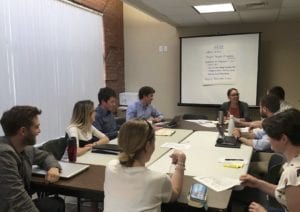Who is a member?
Our members are the local governments of Massachusetts and their elected and appointed leadership.

Members of one of the Somerville Climate Forward working groups meet to discuss progress on developing the plan. (Photo credit: Mike Powers)
Somerville released its first comprehensive climate change plan at the end of November, the culmination of four years of studying and planning to determine steps the city can take within the next five years to build resilience.
The Somerville Climate Forward plan prioritizes 13 action areas supported by 22 key priority actions in order to set Somerville on a path to becoming a resilient, carbon-neutral city.
The plan includes policies, programs and strategies to reduce Somerville’s contribution to climate change, prepare for unavoidable climate change impacts, and fairly distribute the opportunities created by climate action and work to mitigate unequal burdens of climate change.
According to Oliver Sellers-Garcia, Somerville’s sustainability and environment director, the priority action areas were selected based on their ability to solve a key issue identified by either the Climate Change Vulnerability Assessment or the Pathways to Carbon Neutrality Study – studies that the city completed in 2017. The city also completed its first Greenhouse Gas Inventory in 2016.
Short-term goals, which the city aims to implement within three years, include developing an electric vehicle charging infrastructure strategy; pursuing a stormwater enterprise fund to improvement stormwater management; formalizing a modern urban forestry management plan; and setting progressive net-zero building standards for new municipal buildings and those undergoing major renovations.
After the completion of its studies, Sellers-Garcia said, the city undertook an 18-month-long community process, beginning in June 2017, to explore solutions to the challenges laid out in the studies.
“It would not have been as productive if we hadn’t done our homework first,” Sellers-Garcia said. “There’s a lot of things we need to know: What are our primary risks, and what are the places where we can have the most impact?”
For example, through the vulnerability assessment, the city realized that it needs to prioritize addressing rain events that overflow the stormwater system more than coastal flooding of low lying areas.
For the Climate Forward process, the city put together nine different working groups to tackle different areas. Sellers-Garcia said the city hoped to have a couple of community members in each group.
“But the interest was overwhelming, so we actually had 75 community members on these working groups that met three different times, ranging from experts to just people wanting to do something about climate change,” he said.
Sellers-Garcia said the plan tried to focus on some hard targets that the city could complete in the short-term, while not losing focus on long-term goals, in addition to ongoing work such as outreach, education and emergency preparedness.
“There are a lot of climate plans out there that give themselves really long timelines – maybe some interim targets, but you don’t expect to see anything any time soon. That’s not useful for us,” Sellers-Garcia said. “If you want to end up here, let’s not necessarily draw the line to 2050. Let’s realistically look at what we do in the next five years.”